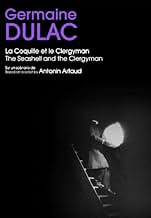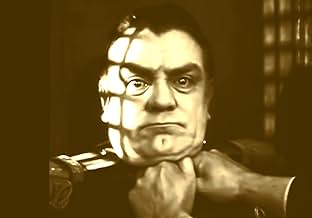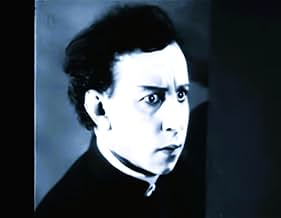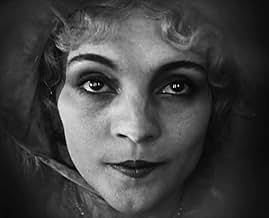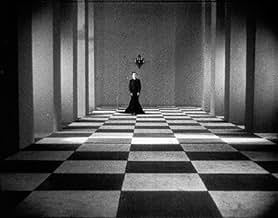La coquille et le clergyman
- 1928
- 40min
VALUTAZIONE IMDb
7,0/10
2394
LA TUA VALUTAZIONE
Ossessionato dalla donna di un generale, un sacerdote ha strane visioni di morte e lussuria, lottando contro il proprio erotismo.Ossessionato dalla donna di un generale, un sacerdote ha strane visioni di morte e lussuria, lottando contro il proprio erotismo.Ossessionato dalla donna di un generale, un sacerdote ha strane visioni di morte e lussuria, lottando contro il proprio erotismo.
- Regia
- Sceneggiatura
- Star
Recensioni in evidenza
Germaine Dulac was no ordinary French female film-director. She was Avante-Garde and radical in her film-making which did not include a laugh track or sound. Everything was visual and her silent classics were visuals to be appreciated and understood by all of us. There was a reason that so many people saw the same movie numerous times during that era. First, it was very inexpensive and second, you needed to revisit and see the film again and again until you saw it completely. That's how films once were, films were visual masterpieces and in Dulac's case, she helped reshape the role of women in films to include more than just being an actress. She was the producer, director, and writer. She was many things to many people on film sets in France. Film was new and fresh invention that those of us who seek to learn more about art should watch Dulac's classic.
The predecessor of Un Chien Andalou and directed by the lone woman filmmaker of her time, La Coquille et le Clergyman is one of the most celebrated of French avant-garde movies of the '20s, partly because Antonin Artaud wrote the script, partly because the British censor of the time banned it with the legendary words 'If this film has a meaning, it is doubtless objectionable'. Artaud was reputedly unhappy with Dulac's realization of his scenario, and it's true that the story's anti-clericalism (a priest develops a lustful passion that plunges him into bizarre fantasies) is somewhat undermined by the director's determined visual lyricism. But the fragmentation of the narrative and the innovative imagery remain provocative, and the film is of course fascinating testimony to the currents of its time.
Surrealism as an art form, emerging in Europe after World War One, was designed to be illogical, but appealing to the subconscious. In cinema, there's debate as to what was the first surrealistic film in history. But there's no doubt filmmaker Germaine Dulac's February 1928 "The Seashell and the Clergyman" could qualify as one of the first containing elements of surrealism in it.
The 40-minute film, about a member of the clergy who lusts after the wife of a general and attempts to suppress such thoughts, is a whirlwind of images disconnected from any plot. Members of the British Board of Film Censors were totally confused by the piece. They wrote Dulac's production was "so cryptic as to be almost meaningless. If there is a meaning, it is doubtless objectionable." The board banned the film in the United Kingdom. Even the book's author "The Seashell and the Clergyman" was based on, Antonin Artaud, a top avant-garde writer, frowned upon Dulac's version.
History, however, has proven more kind to "The Seashell and the Clergyman." Once other surrealistic films were released, most notably 1929's "Un Chien Andalou," whose makers claim was the first in that category, it was apparent that elements found in those films sprung from the images of Dulac's. The French feminist filmmaker, who earlier produced the highly-regarded 1922 "The Smiling Madam Beudet," now is recognized by film historians as the pioneer of surrealism. Her stated goal was to create a new "art of vision," one that through symbolic images reveal a series of metaphors. It was meant to stir the viewer's psyche. Dulac's objective in "The Seashell" was to create an entirely new visual language on the screen, addressing her audience members' unconsciousness. In that, many film critics agree, she succeeded.
The 40-minute film, about a member of the clergy who lusts after the wife of a general and attempts to suppress such thoughts, is a whirlwind of images disconnected from any plot. Members of the British Board of Film Censors were totally confused by the piece. They wrote Dulac's production was "so cryptic as to be almost meaningless. If there is a meaning, it is doubtless objectionable." The board banned the film in the United Kingdom. Even the book's author "The Seashell and the Clergyman" was based on, Antonin Artaud, a top avant-garde writer, frowned upon Dulac's version.
History, however, has proven more kind to "The Seashell and the Clergyman." Once other surrealistic films were released, most notably 1929's "Un Chien Andalou," whose makers claim was the first in that category, it was apparent that elements found in those films sprung from the images of Dulac's. The French feminist filmmaker, who earlier produced the highly-regarded 1922 "The Smiling Madam Beudet," now is recognized by film historians as the pioneer of surrealism. Her stated goal was to create a new "art of vision," one that through symbolic images reveal a series of metaphors. It was meant to stir the viewer's psyche. Dulac's objective in "The Seashell" was to create an entirely new visual language on the screen, addressing her audience members' unconsciousness. In that, many film critics agree, she succeeded.
Obsessed with a general's woman (Genica Athanasiou), a clergyman (Alex Allin) has strange visions of death and lust, struggling against his own eroticism.
"Un chien andalou" is considered the first surrealist film, but its foundations in "The Seashell and the Clergyman" have been all but overlooked. However, the iconic techniques associated with surrealist cinema are all borrowed from this early film. Conversely, Alan Williams has suggested the film is better thought of as a work of or influenced by German expressionism.
I think this is why I absolutely adore this film. I'm enamored with German expressionism, and I love surreal film. This is the two combined, and the acting is superb. Anyone who loves "Un chien" really needs to check this one out.
"Un chien andalou" is considered the first surrealist film, but its foundations in "The Seashell and the Clergyman" have been all but overlooked. However, the iconic techniques associated with surrealist cinema are all borrowed from this early film. Conversely, Alan Williams has suggested the film is better thought of as a work of or influenced by German expressionism.
I think this is why I absolutely adore this film. I'm enamored with German expressionism, and I love surreal film. This is the two combined, and the acting is superb. Anyone who loves "Un chien" really needs to check this one out.
Germaine Dulac has created a monster here... Not in any kaiju sense, but by taking a surreal swipe at just about every element of the masculine-driven, religiously flawed environment of the world in the 1920s. The eponymous priest - Alex Allin harbours none too subtle desires about the mistress of "le général" (Lucien Bataille) - the beautiful Genica Athanasiou, and the next half hour illustrates some of the complex ramifications of this infatuation. Now I have watched this many times, each time thinking as I get older, that the penny may drop and that I shall discover a deeper meaning... Each time, I thoroughly enjoy the intimate, creative imagery and the truly characterful performances, but am still really none the wiser. I think that's what is enthralling about this short enigma of a feature. It stimulates questions, but doesn't answer any of them... Clearly, the director has an agenda, and a political point to make - but we are left to imagine a healthy amount of what this might be about. Is it erotic? Is it about frustration, excess...? I still don't really know....
Lo sapevi?
- QuizThe British Board of Film Censors banned this film in the UK in 1927, saying, "This film is so obscure as to have no apparent meaning. If there is a meaning, it is doubtless objectionable."
- ConnessioniEdited into Women Who Made the Movies (1992)
I più visti
Accedi per valutare e creare un elenco di titoli salvati per ottenere consigli personalizzati
Dettagli
- Data di uscita
- Paese di origine
- Sito ufficiale
- Lingua
- Celebre anche come
- The Seashell and the Clergyman
- Luoghi delle riprese
- Azienda produttrice
- Vedi altri crediti dell’azienda su IMDbPro
- Tempo di esecuzione40 minuti
- Colore
- Mix di suoni
- Proporzioni
- 1.33 : 1
Contribuisci a questa pagina
Suggerisci una modifica o aggiungi i contenuti mancanti

Divario superiore
By what name was La coquille et le clergyman (1928) officially released in Canada in English?
Rispondi
